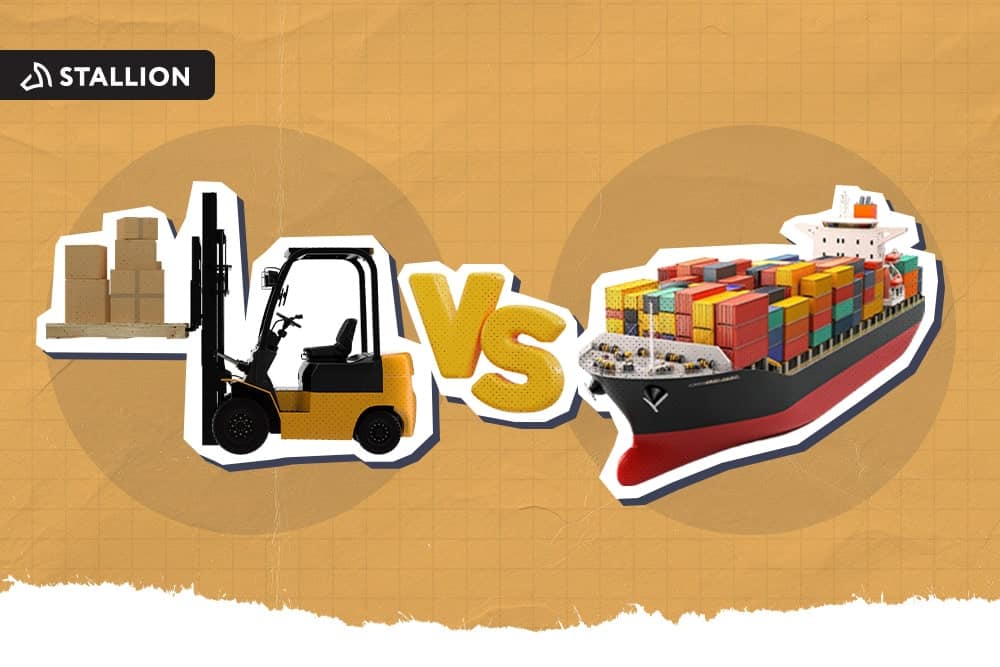
Dealing with the vast Canadian landscape demands a comprehensive understanding of its many logistical challenges and the diverse shipping methods available. Canada, a country spanning thousands of kilometres from coast to coast, offers various options to accommodate varied logistical needs.
Businesses and individuals have various options, from traditional postal services like Canada Post to private courier companies like FedEx and UPS. This introduction explores some of the vital shipping methods available in Canada, highlighting their advantages and considerations.
Canada's expansive geography requires various shipping methods. Before choosing the shipping service, let's check what they are, the disadvantages and the considerations.

Canada Post is the country's national postal service. It is a Crown corporation, which means it’s owned by the Government of Canada. According to a 2022 survey, 57% of companies and businesses prefer to ship their products with Canada Post within Canada. The survey also found that the top reasons are reliability, affordability, and convenience.
Canada Post has built a longstanding reputation for reliability, assuring businesses that the postal service delivers their mail efficiently. Meanwhile, its commitment to affordability ensures businesses of all sizes can access cost-effective domestic shipping services.
Its extensive network adds convenience to the equation and makes sending and receiving packages easier. It has a network of over 6,000 post offices and community mailboxes across Canada, employing around 60,000 people and delivering over 8 billion packages annually.
In addition to the reasons mentioned above, businesses may also choose to ship with Canada Post because it is a Canadian company. About 63% of Canadians prefer Canadian services to support the Canadian economy, create jobs in Canada, and receive high-quality services.
Source: Statista

In a recent survey, researchers found that a significant 43% of Canadians consider using private couriers as the best way to ship within Canada. This preference stems from several compelling reasons, including the remarkable delivery speed and efficiency of private couriers, who are well-known for their quick parcel delivery capacity.
Private couriers like FedEx, UPS, DHL Express, and Purolator are the most popular shipping companies providing shipping options to businesses and consumers. They are not affiliated with any government postal service and frequently cost more than public postal services. Still, they offer more specialized shipping services tailored to meet unique shipping needs, contributing to their popularity among Canadians.
All these couriers and industry leaders present a comprehensive array of shipping options, including expedited shipping, ground service, and overnight shipping. They are great options for shipping various items, including letters, parcels, freight, and specialized items such as temperature-controlled items, hazardous materials, and live animals. In addition, they provide further services, including order processing, warehousing, customs clearance, and freight management.
Source: Statista

In a recent survey conducted in 2022, a significant 65% of Canadian businesses ship their products via freight.
It is the pivotal process of transporting a substantial shipping volume of goods, commodities, and cargo via various modes of transportation, encompassing ships, aircraft, trucks, and intermodal transport combining trains and roads.
Using various transportation options, such as land, air, and sea routes, makes it easier to move freight over national and international borders. Freight shipping is the optimal solution for the conveyance of goods surpassing the size or weight limits typically accommodated by traditional parcel shipping services.
By harnessing the capabilities of this shipping service, businesses and industries can efficiently transport bulky and heavy consignments, ensuring the smooth flow of goods on both domestic and global scales.
There are several different freight shipping methods available, including:
Source: Freightquote

International shipping refers to the process of transporting goods and commodities across national borders to destinations in foreign countries. International services involve complex logistics networks, transportation modes, customs clearance, and documentation to facilitate the global movement of products for trade, commerce, or personal use. Canada offers numerous international shipping services that a small business can take advantage of to expand to the global scene.
Air freight refers to the quick cargo movement via air, connecting countries and continents. Renowned for its unmatched speed, air freight stands as the swiftest method, albeit at a higher cost. It is frequently used for shipping valuable, perishable, or time-sensitive items. Even though it costs more, its capacity to shorten transit times makes a substantial contribution to guaranteeing the prompt delivery of necessary goods and supplies across international borders.
International land freight is transporting goods across borders via road or rail, offering a more economical yet slower alternative to air freight. Typically chosen for non-time-sensitive cargo, it covers various products, including bulk materials, manufactured goods, construction materials, and chemicals.
Although cost-effective and capable of handling large volumes, it is still not the best option for time-sensitive or delicate international shipments. Consulting a reputable freight forwarder helps overcome challenges in land freight complexities.
International sea freight entails the transport of goods between countries via ships, offering affordable shipping prices at the expense of delivery times. Similar to land freight, sea freight is also typically chosen for non-time-sensitive cargo. Furthermore, it can also accommodate various items in large volumes, including bulk goods (grain, coal, and iron ore), manufactured products (automobiles, machinery, and electronics), food and beverages, construction materials, and chemicals.

Cross-border shipping from Canada to the United States is very popular among businesses. The United States is Canada's largest trading partner; cross-border trade between the two countries is worth billions of dollars each year.
On the other hand, Canada is the second most popular country for cross-border online shopping in the US, next only to China. In fact, according to a recent report from research firm eMarketer, 11% of US shoppers have purchased products online from Canada as of 2022.
There are a number of reasons why cross-border shipping from Canada to the US is so popular among businesses:
While cross-border shipping is another form of international service, shipping from Canada to the US differs from shipping to the rest of the world. What makes it different is because of the following reasons:
Beyond these considerations, it's worth noting that these two countries boast a lengthy history of collaboration when it comes to customs and border-related matters. This cooperative approach has been instrumental in crafting a smooth border-crossing process for businesses and individuals.
Rail shipping is a transportation mode that uses trains to transfer goods and commodities between destinations efficiently. This method is common for transporting items between Canada and the United States, using the extensive rail networks in both nations to facilitate cargo movement across the border.
It offers advantages such as cost-effectiveness for large quantities of goods and a reduced environmental footprint compared to other modes of transportation. It plays a significant role in the trade and commerce between these neighbouring countries, ensuring the smooth and reliable transportation of various types of cargo.
Road shipping is a transportation mode relying on trucks to deliver goods from one point to another effectively. Like rail shipping, this method is another common option when shipping items from Canada to the United States, capitalizing on the vast road networks in both countries.
This transport method is celebrated for flexibility, allowing goods to reach diverse destinations, including remote areas. While it may not match the sheer volume capacity of other modes like rail or sea, road shipping excels in offering accessibility, adaptability, and quick deliveries, making it a linchpin in the cross-border trade and commerce between these two neighbouring nations.
Maritime shipping is a shipping method relying on ships to transport goods across various distances efficiently. It is a popular option for moving goods between Canada and the United States, especially when handling large amounts of goods, including commodities, manufactured products, and raw materials. It leverages the vast waterways and ports available along the North American coasts, providing efficient international services.
Air shipping is a transportation method, harnessing airplanes to transport packages across vast distances swiftly. Although there is a monetary drawback, it claims to be the fastest means of transportation in use. Typically reserved for time-sensitive or high-value cargo, air shipping excels in expedited shipping of pharmaceuticals, electronics, and perishables, regularly depending on the on-time delivery guarantee.
Sources: ChannelAdvisor.

According to Pitney Bowes, 1.5 billion parcels were delivered across Canada in 2021 — a consistent number from the previous year. Indeed, a wide range of domestic shipping services are offered in Canada, with numerous carriers providing options to cater to different needs and preferences.
Expedited shipping is a shipping service that delivers packages faster than standard shipping, with a delivery time of one to three business days. Most carriers even offer same-day delivery. However, this option is also more expensive than standard shipping.
Overnight shipping guarantees packages will be delivered the next business day by a certain time. It is typically the fastest shipping service available but also the most expensive. While overnight and expedited shipping offer fast shipping services, you need to keep an eye on some differences.
The key distinction between these two shipping options lies in the delivery timeframe. Overnight shipping ensures your package reaches its destination by the next business day at a specified time. In contrast, expedited parcel shipping denotes faster delivery than standard shipping without guaranteeing next-day arrival.
Flat-rate shipping simplifies the shipping process by charging a consistent shipping price for packages, regardless of the package weight or dimensions. This option is advantageous for businesses and individuals of various sizes and weights.
Postal and courier services typically offer this option. You will need to purchase a special shipping label from the carrier and pack your items in the flat-rate box or envelope provided by the carrier. After packing the items, you must affix the shipping label and drop off the package at a carrier location. Your package will subsequently be delivered to its destination by the carrier.
Shipping to multiple addresses is a service that permits you to send a single order to multiple destinations, offering convenience for businesses with multiple customers or individuals sending gifts to numerous recipients.
Local delivery or pickup service allows customers to have their orders delivered to their doorstep or picked up from a convenient location, typically within the same city or region. Numerous enterprises, including restaurants, grocery stores, retailers, and even individuals, provide this service.
It can be a convenient and affordable option for customers who do not have the time or ability to shop in person. It can also be a good option for businesses offering their customers more flexibility and convenience.
Source: Pitney Bowes
In Canada, the most budget-friendly parcel shipping services often include Canada Post's Expedited Parcel (which can ship packages weighing up to 10kg) and Canada Post's Regular Parcel (which can ship packages weighing up to 30kg).
Meanwhile, if the packages you want to ship exceed 30kg, Purolator Ground and Canpar Ground might offer more economical solutions. However, comparing the rates and services various carriers offer remains crucial to identifying the optimal choice that aligns with your specific shipping requirements.
Choosing the ideal shipping service is a pivotal decision for businesses and individuals. It involves considering factors such as shipping costs, speed, reliability, and specific shipping needs.
Selecting the perfect shipping service is a thorough process that hinges on a comprehensive evaluation of your unique shipping demands. Key considerations include the nature of your products, package weight and dimensions, the shipping distance, and the delivery urgency. By taking into account these critical factors, you can tailor your choice to fit your unique demands, assuring a smooth and economical shipping experience fitting you and your recipient's standards.
Shipping prices are subject to multiple factors, including package weight and size, distance travelled, and preferred delivery time. Thoroughly researching diverse shipping options empowers businesses to identify the cheapest shipping rates aligned with their precise requirements.
According to research, companies that offer various shipping and delivery options tend to experience increased sales. This phenomenon stems from the fact that customers are more inclined to purchase from businesses providing shipping choices that align with their preferences and requirements.
By diversifying their shipping offerings, businesses cater to a broader customer base, accommodating various shipping speeds, costs, and service features. This flexibility not only enhances customer satisfaction but also drives higher conversion rates, positioning businesses for growth and success in a competitive marketplace.
Cost management is essential for brands and businesses seeking profitability, and choosing a shipping service with competitive rates plays a central role in this process. Businesses can effectively curtail their shipping expenses by opting for a shipping provider offering favourable rates, directly impacting their bottom line.
Swift delivery times can significantly boost business efficiency. By utilizing shipping services with expedited delivery options, enterprises can streamline order processing and shipment handling, saving valuable time.
This accelerated pace allows businesses to enhance their operational efficiency, reduce order-to-delivery lead times, and meet customer expectations for speedy service. Moreover, quicker deliveries can increase customer satisfaction, loyalty, and repeat business.
Enhanced efficiency benefits businesses internally and fosters a positive external image, contributing to a competitive edge in the market and overall business growth.
Tracking and visibility tools are invaluable for businesses in pinpointing shipping delays and implementing corrective measures. Through real-time tracking, companies can identify bottlenecks and inefficiencies within their shipping processes, enabling proactive intervention.
Furthermore, customers want more information about their products' whereabouts and anticipated arrival times. Tracking and visibility features empower customers to conveniently monitor their shipments via online platforms or mobile applications, reassuring them and enhancing their overall contentment with the shipping experience.
While shipping services may have imperfections, like the potential for lost, damaged, or stolen packages, shipping protection safeguards businesses from the financial repercussions of such occurrences. This insurance safeguards, reducing the economic impact of unforeseen transit-related disasters.
Due to their added security and financial stability, businesses can traverse these hiccups without suffering large losses. In essence, shipping insurance is a responsible risk management tactic that enables companies to function with assurance in the unpredictably volatile world of logistics and shipping.
In the face of shipping challenges, swift and effective resolution is imperative for businesses. A shipping service distinguished by exemplary customer service is pivotal in expeditiously and efficiently addressing shipping hiccups.
This agility in problem-solving is instrumental in mitigating disruptions and minimizing customer impact. By promptly addressing concerns and providing solutions, businesses can salvage customer relationships and fortify their reputation for reliability and responsiveness.
Diverse shipping services come with distinct packaging prerequisites, underlining the importance of selecting a shipping provider aligning with your specific packaging requirements. Ensuring that the chosen shipping service's packaging criteria harmonize with your needs is essential.
This compatibility streamlines the shipping process, minimizes non-compliance risk, and mitigates the possibility of shipping delays or additional charges associated with packaging discrepancies.
A meticulous evaluation of packaging prerequisites empowers businesses to make informed decisions, uphold packaging integrity, and maintain a seamless shipping workflow, ultimately enhancing the efficiency and cost-effectiveness of their shipping operations.
Like businesses, customers also have their personal shipping preferences. Thus, it is best to consider your target audience before making any decision. For example, if your target audience is consumers, they can be less worried about shipment speed and more price-sensitive. Or, if the target audience lives in small remote towns, you may need to choose a shipping service that offers shipping to remote locations.
Your shipping requirements can evolve, so you need to consider the flexibility and scalability of the shipping service. Seasonal surges in shipping volume or expansion into new geographic markets are common scenarios that warrant adaptability in your chosen shipping solution.
A flexible and scalable shipping service accommodates these changes, ensuring your business operations remain uninterrupted. Such adaptability enables you to pivot swiftly to evolving demands, preventing logistical bottlenecks or service gaps.
Adherence to shipping laws and regulations is crucial. This encompasses various facets, such as shipping hazardous materials, customs compliance, and safeguarding consumer data. Several factors underscore the significance of legal and regulatory compliance:
Selecting the appropriate shipping method in Canada is a critical decision influenced by speed, cost, reliability, and specific needs. Understanding the diverse options, from Canada Post to private couriers and specialized services, empowers businesses and individuals to make informed choices that align with their unique shipping requirements, ultimately ensuring efficient and satisfactory deliveries.

Stallion, a prominent Canadian shipping company, provides a comprehensive range of domestic, international, and freight shipping solutions. Recognized for its competitive pricing, dependable service, and convenient shipping alternatives, Stallion offers several advantages:
Stallion is an excellent choice for those seeking a dependable, cost-effective shipping partner. Their diverse array of services caters to businesses across various industries, ensuring reliable solutions that meet unique shipping needs.
Take advantage of the Opportunities with Stallion - Reach Out Today! Discover competitive rates, reliable service, and tailored shipping options. Whether for domestic, international, or freight shipping needs, Stallion has you covered. Don't wait; take advantage of our expertise and savings now!
Aman looks after the content marketing department at Stallion Express. He is passionate about helping businesses grow by providing informative and up-to-date trends in the eCommerce industry. Outside the office, you can find him on the soccer field cheering on Real Madrid.



Can our fellow Torontonians relate?
-
#smallbusiness #business #entrepreneur #socialmedia #shipping #ecommerce #canadianecommerce #shopify #poshmark #b2b #saas #etsy #ebay #canada #canadiansmallbusiness #shoplocalcanada #entrepreneur
#toronto

Here’s your quick hassle free shipping from 🇨🇦 to 🇺🇸 as a business owner!
-
Any questions?! Leave them 👇🏻 and save this video so you don’t forget!
-
#smallbusiness #business #entrepreneur #socialmedia #shipping #ecommerce #canadianecommerce #shopify #poshmark #b2b #saas #etsy #ebay #canada #canadiansmallbusiness #shoplocalcanada #entrepreneur

Meet @drinkbenny a 🇨🇦 female founded energy drink brand! Instead of focusing on their products, they’re taking a unique approach by hosting in person events in different Canadian cities to offer an experience for their community 🧡
-
What are your thoughts on in person events? 💭
-
#smallbusiness #business #entrepreneur #socialmedia #shipping #ecommerce #canadianecommerce #shopify #poshmark #b2b #saas #etsy #ebay #canada #canadiansmallbusiness #shoplocalcanada #entrepreneur

Do you know the difference between DDU and DDP when shipping internationally 🌏 ?
-
Questions? Leave them below! 👇🏻
-
#smallbusiness #business #entrepreneur #socialmedia #shipping #ecommerce #canadianecommerce #shopify #poshmark #b2b #saas #etsy #ebay #canada #canadiansmallbusiness #shoplocalcanada #entrepreneur

Here’s a quick hack to save time from choosing multiple postage options
↪️ Turn on the lowest postage rate automation to save you time!
-
Questions? Leave them below! 👇🏻
-
#smallbusiness #business #entrepreneur #socialmedia #shipping #ecommerce #canadianecommerce #shopify #poshmark #b2b #saas #etsy #ebay #canada #canadiansmallbusiness #shoplocalcanada #entrepreneur
